
 |
Tea Clipper |
 |
| from TeaAntiques.com | ||
| Edition Forty Five |
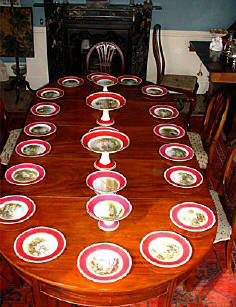 A magnificent and comprehensive English dessert service dating
from c1880. This very grand dessert service comprises 18 dessert plates, 3 small
comports, 2 medium comports and 2 very large comports. All of the pieces of the
set are individually painted with very attractive and romantic scenes that
include castles (one of which is Warwick Castle, which is the subject of this
newsletter), houses, ruins, naturalistic features and even a pier. What also
makes this a special service is that each of the pieces has the name of the
scene painted by hand on the back, so each is identified.
A magnificent and comprehensive English dessert service dating
from c1880. This very grand dessert service comprises 18 dessert plates, 3 small
comports, 2 medium comports and 2 very large comports. All of the pieces of the
set are individually painted with very attractive and romantic scenes that
include castles (one of which is Warwick Castle, which is the subject of this
newsletter), houses, ruins, naturalistic features and even a pier. What also
makes this a special service is that each of the pieces has the name of the
scene painted by hand on the back, so each is identified.
Here are the pictures of the small comport that is beautifully painted with a view of Warwick Castle and as identified on the underside of the foot of the comport.
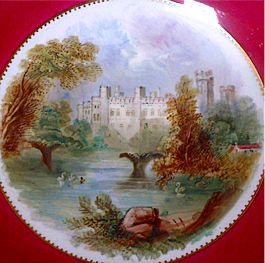
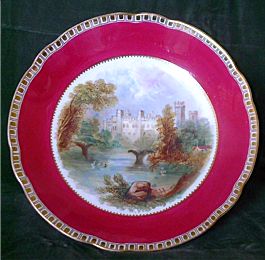
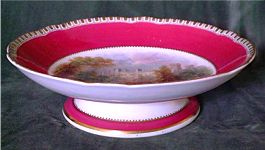
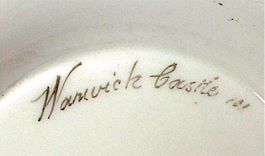
The entire service is painted with such delightful scenes as this and would make a spectacular display service and would certainly make a conversation piece when used at dinner.
More details of this item and other tea related antiques can be found by visiting my web site at www.TeaAntiques.com.
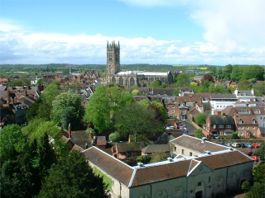 In
central England is the charming town of Warwick, its dominant Castle on the
South East side of the town looking out over the flat landscape over the river
Avon.
In
central England is the charming town of Warwick, its dominant Castle on the
South East side of the town looking out over the flat landscape over the river
Avon.
Warwick is situated on a hill and comprises a beautiful mixture of medieval, Queen Anne, Georgian and later fine buildings. Many of the original medieval buildings in the town's High Street were destroyed by the great fire there in 1694, but this then allowed for the re-development with the building of some elegant Queen Anne red brick houses in a more formal style than the old medieval houses.
Despite the great fire that raged through a part of the town in the end of the seventeenth century, there are still many streets with quaint timber framed houses from this period. A fine example of such houses are in Mill street, so named as it led down to the old Mill which was next to the Castle on the banks of the river Avon. Here, the buildings show the jettied oak frame work with patterned brickwork between, this sometimes plastered over and painted. From Mill Street, there are some glimpses up at the historic Castle.
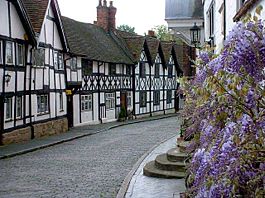
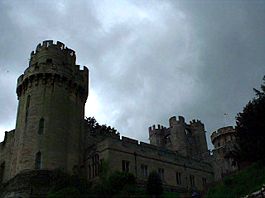
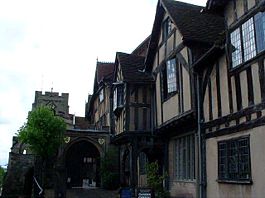 Warwick
epitomises what an English town should be like. A town nestling against its
older protective Castle, built on high ground where there were good defences
against marauding enemies. A fine example of the earlier buildings within
Warwick is the Lord Leycester Hospital. Lord Leycester, a favourite of Queen
Elizabeth I, built this hospital to house his troops retired from his armies.
Today, this building is open to the public with many interesting features
including the chapel, Great Hall, galleried courtyard and Guildhall. Also housed
in this building today, a tearoom in what had originally been the Brethren's
kitchen, where all retired soldiers could play a part in preparing meals.
Warwick
epitomises what an English town should be like. A town nestling against its
older protective Castle, built on high ground where there were good defences
against marauding enemies. A fine example of the earlier buildings within
Warwick is the Lord Leycester Hospital. Lord Leycester, a favourite of Queen
Elizabeth I, built this hospital to house his troops retired from his armies.
Today, this building is open to the public with many interesting features
including the chapel, Great Hall, galleried courtyard and Guildhall. Also housed
in this building today, a tearoom in what had originally been the Brethren's
kitchen, where all retired soldiers could play a part in preparing meals.
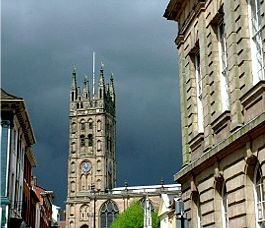 The
town Square is dominated by the church of St Mary's, its fine square tower a
landmark looming up above the rest of Warwick's buildings. Around the Square and
town are some antique markets to provide some diversion and interest to visitors
as well as to visit the beautiful Castle and its attractive grounds.
The
town Square is dominated by the church of St Mary's, its fine square tower a
landmark looming up above the rest of Warwick's buildings. Around the Square and
town are some antique markets to provide some diversion and interest to visitors
as well as to visit the beautiful Castle and its attractive grounds.
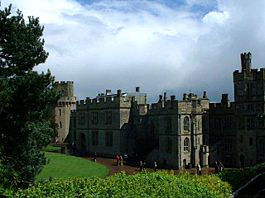 The
Castle in Warwick, I must say, was very good value for money and provides a
living experience into the ways of Medieval life as well as a glance into later
periods in the Castle's History, including the Georgian and Victorian eras.
The
Castle in Warwick, I must say, was very good value for money and provides a
living experience into the ways of Medieval life as well as a glance into later
periods in the Castle's History, including the Georgian and Victorian eras.
Having
bought the ticket at the old stable block, a short walk leads to the Gatehouse
and Barbican.
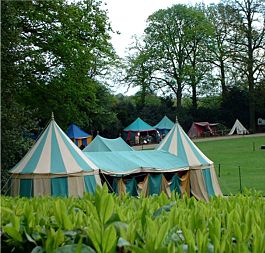 On this short walk are often demonstrations of Medieval life such
as archery and falconry. Striped Medieval style tents along the route are used
to house actors and groups who do the demonstrations.
On this short walk are often demonstrations of Medieval life such
as archery and falconry. Striped Medieval style tents along the route are used
to house actors and groups who do the demonstrations.
The first actual Castle built on the site of the present Warwick Castle was a wooden Motte and Bailey construction built upon the orders of William the Conqueror in 1068. This early Castle was slowly changed with a stone-built Castle that continued to grow through the Middle Ages to the 14th century. Owned by the Earls of Warwick, the Beauchamp family, it became a mighty stronghold for their family as well as a fortress.
The Castle has seen a turbulent history that includes an attack in 1264, besieged in 1642 and damaged by fire in 1871. It remained the home of the Earls of Warwick until 1978. It was then taken over by the Tussauds Group, who are famous for their wax works of famous people. This is evident when going round the Castle, as many of the rooms contain displays with wax work people - an excellent idea to bring the Castle to life from the past once more.
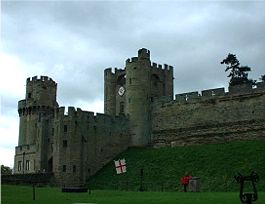
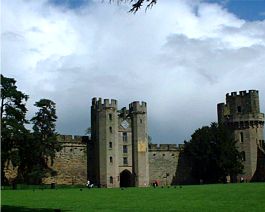
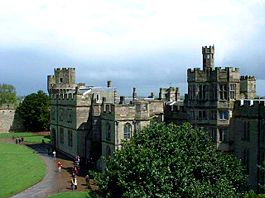 Entering
in the Castle compound itself, we pass through the barbican, the part of the
Gatehouse that extends out over the ditch with its drawbridge. Having passed
through this defensive structure into the Castle courtyard, we get our first
views of the walled compound and the turreted Castle buildings within.
Entering
in the Castle compound itself, we pass through the barbican, the part of the
Gatehouse that extends out over the ditch with its drawbridge. Having passed
through this defensive structure into the Castle courtyard, we get our first
views of the walled compound and the turreted Castle buildings within.
To the left are the castle Apartments including the State Apartments, along with the Great Hall and Chapel.
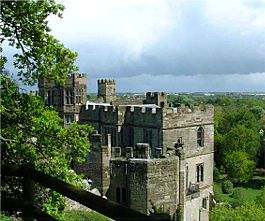 Cleverly,
the tour of the Castle is divided into certain eras. There is the 'Royal Weekend
Party' which takes us through the Victorian rooms of the Castle, set as for a
weekend party, including the Royal guests of Prince Edward (later King Edward
VII), and Prince George, later to become George V. Then, in the State Rooms, we
see the Georgian rooms with the State Dining Room set for a very fine dinner
party. Then around the outer buildings of the Castle and also in the basement or
Dungeons, are sets depicting earlier times in the history of the castle by
modelled tableaus.
Cleverly,
the tour of the Castle is divided into certain eras. There is the 'Royal Weekend
Party' which takes us through the Victorian rooms of the Castle, set as for a
weekend party, including the Royal guests of Prince Edward (later King Edward
VII), and Prince George, later to become George V. Then, in the State Rooms, we
see the Georgian rooms with the State Dining Room set for a very fine dinner
party. Then around the outer buildings of the Castle and also in the basement or
Dungeons, are sets depicting earlier times in the history of the castle by
modelled tableaus.
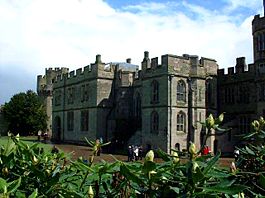 I
started my tour of the Castle with the 'Royal Weekend party'. This is
effectively a recreation, using wax models, of a Royal weekend party that
Frances, Duchess of Warwick (lovingly known as Daisy) arranged in 1898. Her
Royal and distinguished guests included Prince Edward, with his son Prince
George and young Winston Churchill, later to become Sir Winston Churchill, the
Prime minister.
I
started my tour of the Castle with the 'Royal Weekend party'. This is
effectively a recreation, using wax models, of a Royal weekend party that
Frances, Duchess of Warwick (lovingly known as Daisy) arranged in 1898. Her
Royal and distinguished guests included Prince Edward, with his son Prince
George and young Winston Churchill, later to become Sir Winston Churchill, the
Prime minister.
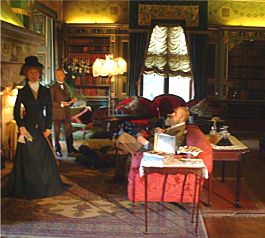
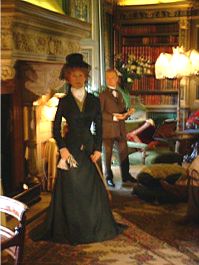 The
first main room is the Library, a masculine room in which the gentleman could be
alone to chat and drink while the ladies of the house were maybe taking tea and
chatting in the Drawing Room. However, in this tableau, Daisy, the Countess, has
decided to break the rules and join the gentlemen! She stands near to the
fireplace in her morning riding gear, including a top hat and black dress.
Edward, Prince of Wales, is reclining on the settee smoking one of his famous
cigars and enjoying a glass of drink. Standing in the window, the figure of Winston Churchill. The idea is that Daisy is there to finalise arrangements for
the evening's events. The Library is furnished with much of the original
furniture and decorated as it was at this point in time.
The
first main room is the Library, a masculine room in which the gentleman could be
alone to chat and drink while the ladies of the house were maybe taking tea and
chatting in the Drawing Room. However, in this tableau, Daisy, the Countess, has
decided to break the rules and join the gentlemen! She stands near to the
fireplace in her morning riding gear, including a top hat and black dress.
Edward, Prince of Wales, is reclining on the settee smoking one of his famous
cigars and enjoying a glass of drink. Standing in the window, the figure of Winston Churchill. The idea is that Daisy is there to finalise arrangements for
the evening's events. The Library is furnished with much of the original
furniture and decorated as it was at this point in time.
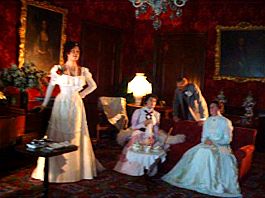 In
the next room, the Music room, others are enjoying a little musical soirée and
are listening to Clara Butt, a famous singer of the day, entertaining them with a
few of her songs. She is accompanied by a gentleman playing on the grand piano.
The ladies on the comfortable Victorian red settee are the Duchess of Devonshire
and Lady Randolph Churchill (Winston Churchill's mother), with a Gentleman,
George Cornwallis-West, stood behind, have been enjoying a cup or two of tea.
The tea laid out on a small table in front of them on a starched white cloth and
set with Victorian tea wares. The room is hung with rich red wall paper and hung
round with portraits of Family members.
In
the next room, the Music room, others are enjoying a little musical soirée and
are listening to Clara Butt, a famous singer of the day, entertaining them with a
few of her songs. She is accompanied by a gentleman playing on the grand piano.
The ladies on the comfortable Victorian red settee are the Duchess of Devonshire
and Lady Randolph Churchill (Winston Churchill's mother), with a Gentleman,
George Cornwallis-West, stood behind, have been enjoying a cup or two of tea.
The tea laid out on a small table in front of them on a starched white cloth and
set with Victorian tea wares. The room is hung with rich red wall paper and hung
round with portraits of Family members.
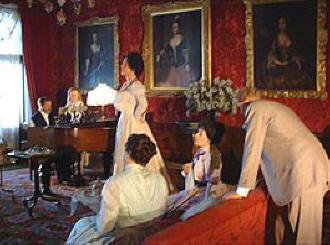
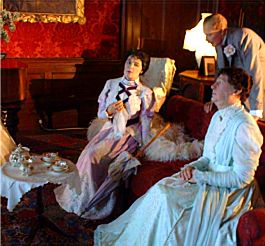
Next to the Music Room is the Smoking Room. Again the domain of the gentlemen - a place for them to maybe play at cards and enjoy a smoke out of the ladies' presence. The tableau in this room depicts a game of cards between Charles Spenser Churchill, 9th Duke of Marlborough owner of Blenheim Palace and the Duke of York, George, later to be King George V. The Duke of York is sat on a Victorian 'club fender' in front of a roaring fire, about to light up a cigarette. They play at cards upon a fold-over green baize lined card table- no doubt for a small wager!
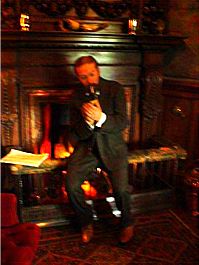
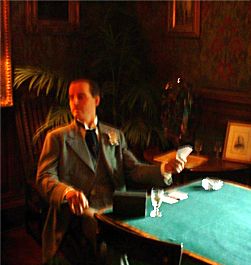
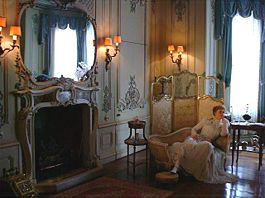 A
different type of atmosphere greets us in the Ladies' Boudoir, very much a ladies'
room with light pained French panelling to the walls and delicate gilt framed
French furniture. This panelling and furniture originates from a French Chateau.
Here we see Daisy's half-sister Millicent, Duchess of Sutherland with her friend
Lady Sackville-West. Millicent is repost on a Chaise Lounge with a table to the
side on which are the tea things, including a silver tea kettle on stand on the
under self of the table. Lady Sackville-West is seen to be catching up on some
of her correspondence at a very attractive French desk attended by a liveried
footman.
A
different type of atmosphere greets us in the Ladies' Boudoir, very much a ladies'
room with light pained French panelling to the walls and delicate gilt framed
French furniture. This panelling and furniture originates from a French Chateau.
Here we see Daisy's half-sister Millicent, Duchess of Sutherland with her friend
Lady Sackville-West. Millicent is repost on a Chaise Lounge with a table to the
side on which are the tea things, including a silver tea kettle on stand on the
under self of the table. Lady Sackville-West is seen to be catching up on some
of her correspondence at a very attractive French desk attended by a liveried
footman.
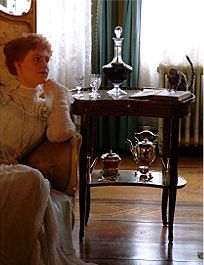
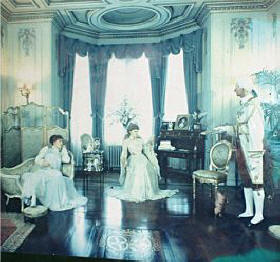
Daisy's bedroom is set to show her being dressed for the evening's grand dinner party, by her maid. This room decorated for the late 1890s shows a much more light and delicate air than the heavier Victorian period of darker colours and dark wood panelling. Her dress would have been specially designed for her on this grand occasion.
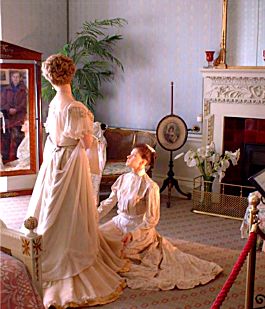
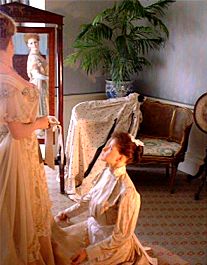
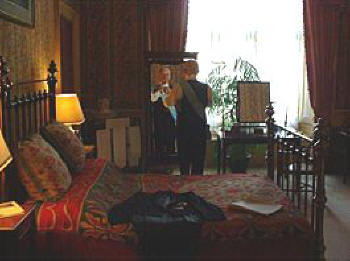
In a bedroom on the other side of the corridor is Field Marshall Lord Roberts preparing himself for dinner, tying his own bow tie in front of a cheval mirror.
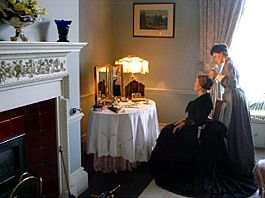 The
Dowager Countess meanwhile is in her room attended by her maid who is putting
the finishing touches to her mistress's hair. The Dowager Countess, is the
widowed wife of the 4th Earl of Warwick and who having relinquished the Castle
to her daughter and son-in Law, now the 5th earl, now resides in her London
house, here returned to Warwick for the weekend.
The
Dowager Countess meanwhile is in her room attended by her maid who is putting
the finishing touches to her mistress's hair. The Dowager Countess, is the
widowed wife of the 4th Earl of Warwick and who having relinquished the Castle
to her daughter and son-in Law, now the 5th earl, now resides in her London
house, here returned to Warwick for the weekend.
The Earl of Warwick in 1893 is in his Dressing Room and is waiting for his bath to be drawn by his man servant. This bath being run from a bath kettle into the slipper bath set ready for the Earl.
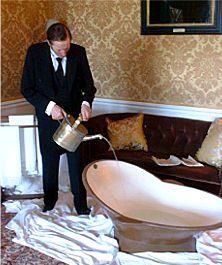
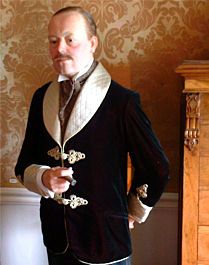
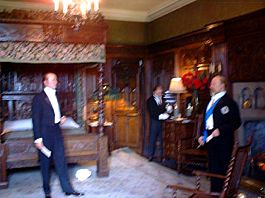 In
the Kenilworth Bedroom, so named because some of the wood panelling on the walls
came from Kenilworth castle, is the Prince of Wales. This was his favourite
bedroom on his many visits to Warwick castle and he is seen here standing in
front of the fire place with a fat cigar in his hand.
In
the Kenilworth Bedroom, so named because some of the wood panelling on the walls
came from Kenilworth castle, is the Prince of Wales. This was his favourite
bedroom on his many visits to Warwick castle and he is seen here standing in
front of the fire place with a fat cigar in his hand.
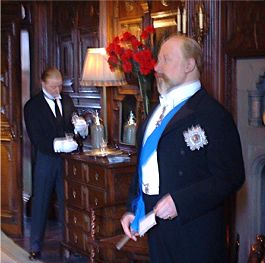 He is being poured a
pre-dinner drink by the valet. He is attended by Lord Curzon, who was in 1898
made Viceroy of India by Queen Victoria, they discuss poignant matters of the
day prior to the evening's grand dinner.
He is being poured a
pre-dinner drink by the valet. He is attended by Lord Curzon, who was in 1898
made Viceroy of India by Queen Victoria, they discuss poignant matters of the
day prior to the evening's grand dinner.
Having enjoyed this tour of part of the Castle, I will return in the next Tea Clipper to view the grand State Apartments. I hope that you will join me for this second part of the tour.
Warwick Castle
Warwick
Tel: 0870 442 2000
Website: http://www.warwick-castle.co.uk
Click here for a
Map
Map courtesy of www.streetmap.co.uk
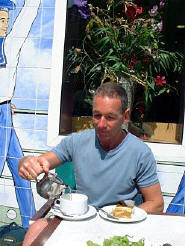 On
a recent trip to France, I enjoyed tea at a Café in Cherbourg called 'Pompoms',
where I had a delightful, light and moist slice of Lemon cake. This I thought to
be a
very suitable cake to enjoy with afternoon tea back home.
On
a recent trip to France, I enjoyed tea at a Café in Cherbourg called 'Pompoms',
where I had a delightful, light and moist slice of Lemon cake. This I thought to
be a
very suitable cake to enjoy with afternoon tea back home.
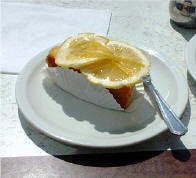 Thus it inspired me to
have a go at making one of these tangy cakes. I found a very apt recipe in a
charming little afternoon tea book 'Tea with the Bennets - of Jane Austen's
Pride and Prejudice', An Anthology of Recipes by Margaret Vaughan (ISBN 1 86123
065 6). In this book, which has some fine recipes for afternoon tea delights, I
found 'Lemon Cake'.
Thus it inspired me to
have a go at making one of these tangy cakes. I found a very apt recipe in a
charming little afternoon tea book 'Tea with the Bennets - of Jane Austen's
Pride and Prejudice', An Anthology of Recipes by Margaret Vaughan (ISBN 1 86123
065 6). In this book, which has some fine recipes for afternoon tea delights, I
found 'Lemon Cake'.
As the recipe stated that it works equally well with oranges or limes, I would make my afternoon tea cake for this occasion an orange one - just to be different.
The results of the cake made to this recipe were absolutely divine, tangy and so very moist. It is a cake recipe that I would strongly recommend as, not only is it a fine tasting cake for an afternoon tea, it is also a simple cake to make.
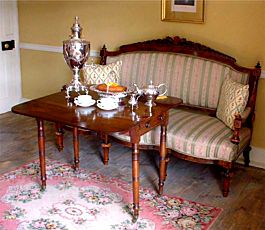
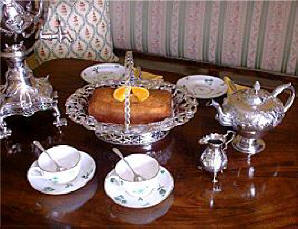
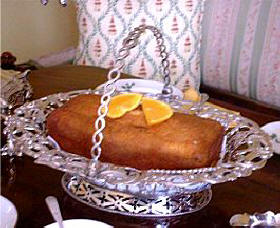
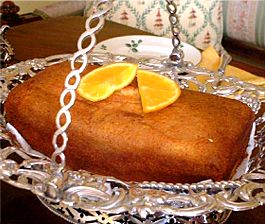 To
do justice to this cake from a book relating to cakes and tea time treats from
the time of Jane Austen, I thought that it deserved the best of settings.
Therefore, I
created what I think is the ideal period tea table using a few antique items of
silver and porcelain.
To
do justice to this cake from a book relating to cakes and tea time treats from
the time of Jane Austen, I thought that it deserved the best of settings.
Therefore, I
created what I think is the ideal period tea table using a few antique items of
silver and porcelain.
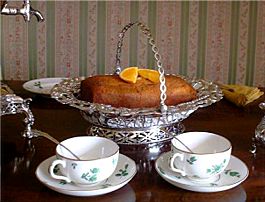 A
simple setting, such as this, can create such a perfect atmosphere for that
elegant period afternoon tea. Here, I have used a fine Georgian tea urn, Silver
inverted pear-shaped teapot and baluster milk jug. To present the cake at its
best, what could be more perfect than a fine George III filigree silver cake
basket, with swing handle made by Robert Makepeace, London 1768. Such a basket
cannot fail to impress afternoon tea guests.
A
simple setting, such as this, can create such a perfect atmosphere for that
elegant period afternoon tea. Here, I have used a fine Georgian tea urn, Silver
inverted pear-shaped teapot and baluster milk jug. To present the cake at its
best, what could be more perfect than a fine George III filigree silver cake
basket, with swing handle made by Robert Makepeace, London 1768. Such a basket
cannot fail to impress afternoon tea guests.
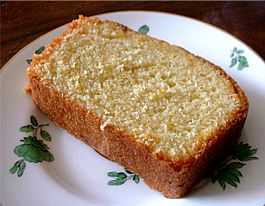
With full credit to the author of this book, I have given the recipe as I interpreted it to make this beautiful cake:
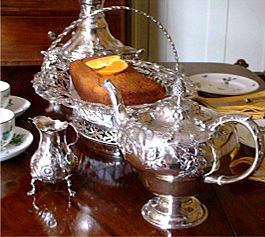 Whisk the butter, sugar and grated orange rind together until the mixture
is well mixed and is light and fluffy. Gradually beat in the eggs a little at a
time.
Whisk the butter, sugar and grated orange rind together until the mixture
is well mixed and is light and fluffy. Gradually beat in the eggs a little at a
time.
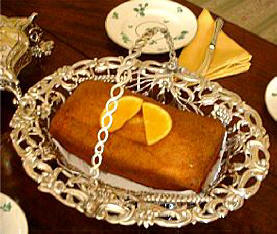 I
hope that you too have a go at this wonderful moist and tangy tasty cake and
enjoy it at one of your own afternoon teas.
I
hope that you too have a go at this wonderful moist and tangy tasty cake and
enjoy it at one of your own afternoon teas.
To review past newsletters, just follow this link:
Past newsletters.
To subscribe to this free newsletter -
Click here